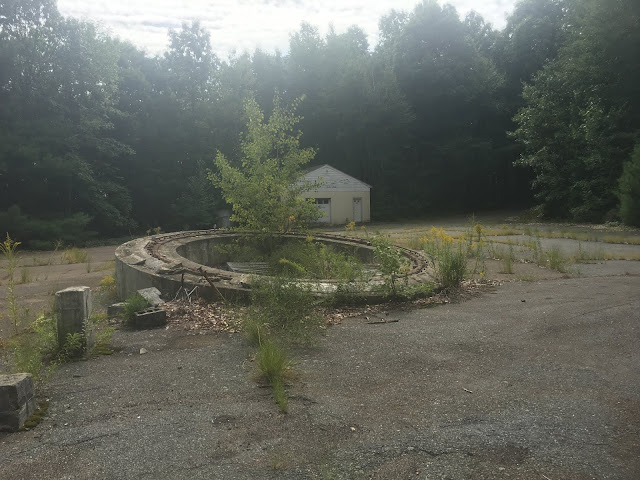I'm also a fan of anything abandoned, having spent the past several years exploring dozens of places that are forgotten and neglected. It's a rare occasion these two worlds would ever have an opportunity to meet, but that's just what happened when I explored an abandoned observational campus in the woods of Harvard Massachusetts.
Opened in 1933, Oak Ridge once operated the largest optical telescope east of Texas, and is credited with the discovery of 38 minor (dwarf) planets and asteroids within our solar system. Oak Ridge also boasted of an 84-foot radio telescope which was used in Project BETA, their search for extraterrestrial intelligence. More on that one in a bit.
The dome below housed a telescope called the 16" Boller and Chivens Cassegrain reflector. While it is no longer inside, if you visit the the National Air and Space Museum's Public Observatory in Washington, DC, you may get a chance to use that very piece of equipment. What used to operate within this building has been relocated there for public use.
I took the above picture while standing on this cement platform, which once held a pair of open-air scopes called the Damon Patrol Cameras.
The largest building at this complex is this funny cylindrical structure which is home to the massive 61" Wyeth telescope, first installed in 1934 and then upgraded with a Pyrex mirror in 1936. Pyrex is less prone to warping with changes in air temperature than glass, beneficial when the roof was rolled back and the telescope exposed to cold night air. This telescope was operated in partnership with the Smithsonian Astrophysical Observatory until the complex shut down in 2005.
What I assumed was a small storage shed I later learned was the observatory's darkroom, housed in its own building.
It wasn't just the skies researchers studied at this facility - sometimes they looked down. Below is the seismograph building where the US Geological Survey measured tremors, then by triangulating these tremors with other facilities were able to pinpoint the source of the disturbance.
Walk a little ways into the woods and you'll find a beautiful stone building, where researchers once lived.
Though impressive in its day, as anyone who's ever owned the same cell phone for more than a few years knows, technology moves at a rapid pace. What was once state of the art is now abandoned scraps on a hilltop in Massachusetts. That doesn't mean the university has given up its research, however, they just now operate out of a newer facility at the Harvard-Smithsonian Center for Astrophysics in nearby Cambridge.
Before you go running for the home button on your browser, hear me out. When considering whether life exists outside of Earth there are two distinct groups. One you know of already, the group that classifies any bright light in the sky as a UFO - great for an afternoon of entertainment on YouTube. Then there is the SETI community - legitimate scientists under the assumption that with trillions of stars in our universe, life almost certainly has arisen elsewhere. But they go looking for it in a very different way.
Imagine trying to figure out whether life exists here on Earth, from light years away. One method would be the massive engineering feat of sending spaceships to our planet to have a look; doable but improbable. A much easier method would be to simply sit back and listen. With a strong enough receiver, even from many light years away you'd be able to pick up all sorts of signals "leaking" from our planet, including early television programs and military communications. A big joke among the scientific community is that searchers on a planet 60 light years from us might actually be receiving episodes of I Love Lucy at this very moment. SETI searches the skies for these signals leaking away from other star systems, and although nothing has been found definitively yet, a few signals have given searchers hope. One of those was a reception called the "Wow!" signal, picked up back in the 70's.
Just how much of a nerd am I when it comes to this stuff? I'm writing this while drinking coffee from my SETI mug, something I purchased off the seti.org website over 10 years ago. I've been following them for a long time now, and one of my greatest hopes is that they find a conclusive signal at some point within my lifetime.











I live in the Town next to Harvard & visit Oak Ridge from time to time. It is sad to see it no longer in use. Back in the 70s I was friends with the on site observer & spend many hours in the Central Building and in the observer's cottage. Great memories
ReplyDeleteHello, is there anyone still living in or near Harvard that can talk about what it was like there? We are writing a radio story on this and are seeking out the accounts of those who may still remember working at or visiting this special place.
DeleteVery cool memory, thanks for sharing!
ReplyDeleteI grew up in Harvard and remember going on a tour of the radio telescope as a primary school student. It was sad to see it in such disrepair once I was in high school and now it is gone. I too enjoy poking around the abandoned bits of the world and I like to think people 150 years from now may come across this site the way we happen upon a stone foundation in the woods today
ReplyDeleteIt's a bummer seeing a place like this left to crumble, but you'll be happy to know it found a second life. I was watching the TV show Castle Rock recently, and much of the setting for season 2 was this very place!
DeleteDave